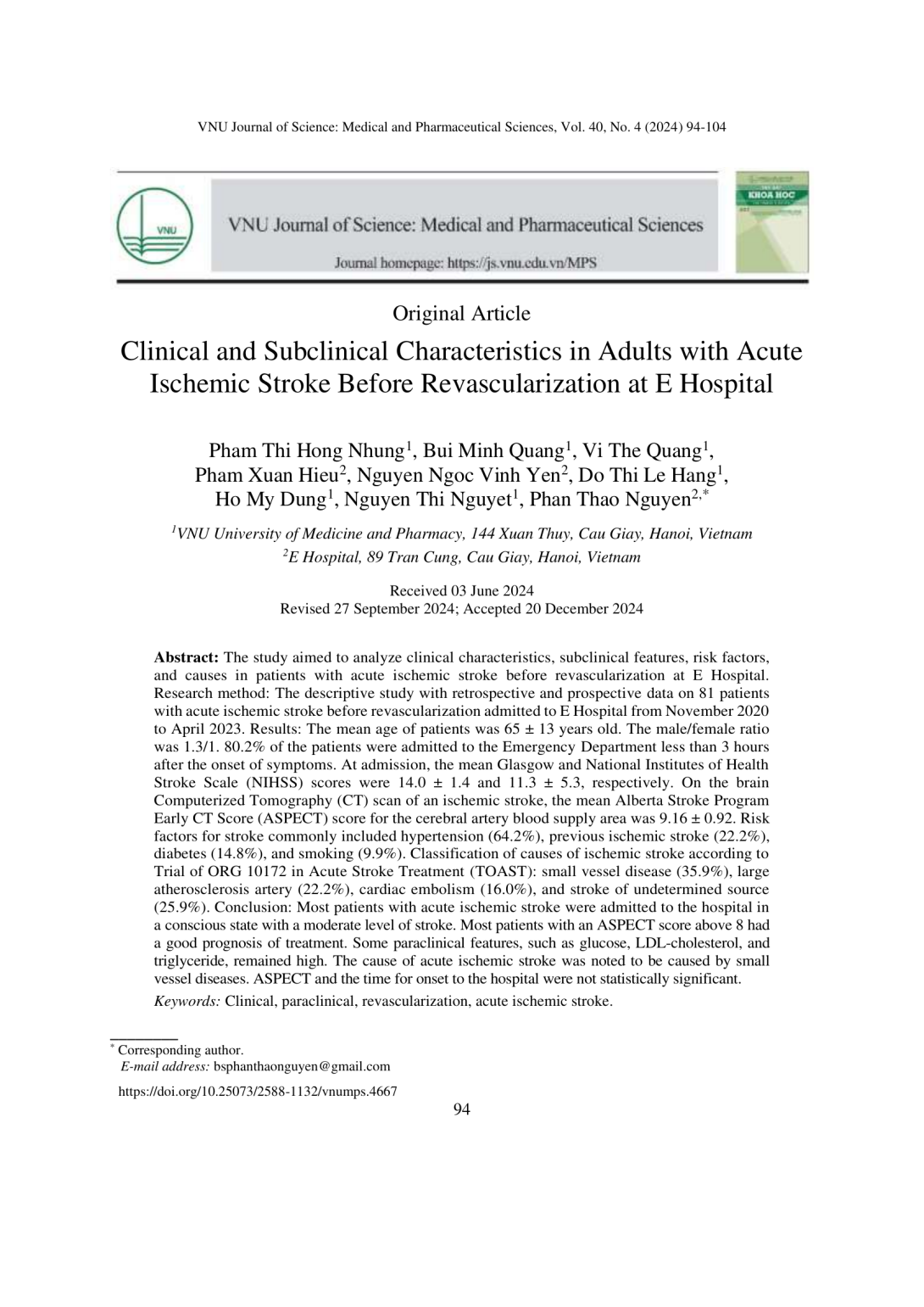
Nghiên cứu nhằm phân tích đặc điểm lâm sàng, cận lâm sàng, yếu tố nguy cơ và nguyên nhân ở người bệnh (NB) nhồi máu não (NMN) cấp trước khi tái thông mạch máu tại Bệnh viện E. Phương pháp nghiên cứu: nghiên cứu mô tả có hồi cứu và tiến cứu trên 81 NB đột quỵ NMN cấp trước khi can thiệp tái thông mạch nhập viện tại Bệnh viện E, từ tháng 11/2020 đến tháng 04/2023. Kết quả: Tuổi trung bình của NB là 65 ± 13 tuổi. Tỉ lệ nam/nữ =1,3/1. Có 80,2% NB đến viện cấp cứu sau khi khởi phát bệnh trước 3 giờ. Về lâm sàng, NB tại thời điểm nhập viện có điểm Glasgow trung bình là 14,0 ± 1,4, điểm NIHSS (National Institutes of Health Stroke Scale) trung bình là 11,3 ± 5,3 điểm. Về cận lâm sàng, điểm ASPECT (Alberta Stroke Program Early CT Score) thời điểm nhập viện cho vùng cấp máu của động mạch não trung bình là 9,16 ± 0,92 điểm. Các yếu tố nguy cơ đột quỵ não thường gặp trên NB gồm tăng huyết áp (64,2%), NMN cũ (22,2%), đái tháo đường (14,8%), hút thuốc lá (9,9%). Phân loại các nguyên nhân gây NMN cấp theo TOAST (Trial of ORG 10172 in Acute Stroke Treatment): nguyên nhân bệnh mạch máu nhỏ (35,9%), bệnh mạch máu lớn (22,2%), lấp mạch từ tim (16,0%) và các nguyên nhân chưa xác định (25,9%). Kết luận: phần lớn người bệnh NMN cấp vào viện với tình trạng tỉnh táo với mức độ đột quỵ trung bình. Đa số NB có điểm ASPECT > 8 có tiên lượng tốt trong điều trị. Một số xét nghiệm như glucose máu, LDL-cholesterol, triglycerid vẫn ở mức cao. Nguyên nhân gây NMN do bệnh lý mạch máu nhỏ chiếm phần lớn. Không tìm thấy mối liên hệ giữa điểm ASPECT với thời gian từ khi khởi phát đến khi vào viện.
The study aimed to analyze clinical characteristics, subclinical features, risk factors, and causes in patients with acute ischemic stroke before revascularization at E Hospital. Research method: The descriptive study with retrospective and prospective data on 81 patients with acute ischemic stroke before revascularization admitted to E Hospital from November 2020 to April 2023. Results: The mean age of patients was 65 ± 13 years old. The male/female ratio was 1.3/1. 80.2% of the patients were admitted to the Emergency Department less than 3 hours after the onset of symptoms. At admission, the mean Glasgow and National Institutes of Health Stroke Scale (NIHSS) scores were 14.0 ± 1.4 and 11.3 ± 5.3, respectively. On the brain Computerized Tomography (CT) scan of an ischemic stroke, the mean Alberta Stroke Program Early CT Score (ASPECT) score for the cerebral artery blood supply area was 9.16 ± 0.92. Risk factors for stroke commonly included hypertension (64.2%), previous ischemic stroke (22.2%), diabetes (14.8%), and smoking (9.9%). Classification of causes of ischemic stroke according to Trial of ORG 10172 in Acute Stroke Treatment (TOAST): small vessel disease (35.9%), large atherosclerosis artery (22.2%), cardiac embolism (16.0%), and stroke of undetermined source (25.9%). Conclusion: Most patients with acute ischemic stroke were admitted to the hospital in a conscious state with a moderate level of stroke. Most patients with an ASPECT score above 8 had a good prognosis of treatment. Some paraclinical features, such as glucose, LDL-cholesterol, and triglyceride, remained high. The cause of acute ischemic stroke was noted to be caused by small vessel diseases. ASPECT and the time for onset to the hospital were not statistically significant.
- Đăng nhập để gửi ý kiến
